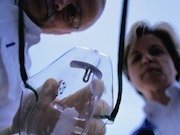Negative behavior linked to higher mean, maximum concentrations in anesthesiologist’s breathing zone
WEDNESDAY, Nov. 22, 2017 (HealthDay News) — Negative behavior among children undergoing elective ear, nose, and throat surgery is associated with higher mean and maximum sevoflurane concentrations in the anesthesiologist’s breathing zone, according to a study published online Oct. 25 in Pediatric Anesthesia.
Jennifer Herzog-Niescery, M.D., from Ruhr-University Bochum in Germany, and colleagues described how child behavior affects the amount of waste sevoflurane in anesthesiologists’ breathing zones. The authors recruited 68 children aged 36 to 96 months undergoing elective ear, nose, and throat surgery. After oral midazolam premedication, patients obtained sevoflurane using a face mask. Ventilation was supported manually, and a venous catheter was placed. The concentration of inspiratory sevoflurane was reduced, and remifentanil and propofol were administered before removal of the face mask and insertion of a cuffed tracheal tube. The anesthesiologist assessed the child’s behavior toward the operating room personnel. Sevoflurane concentrations were determined in the anesthesiologists’ breathing zone by continuous photoacoustic gas monitoring.
The researchers found that the mean and maximum sevoflurane concentrations (Cmean and Cmax) were 4.38±4.02 ppm and 70.06±61.08 ppm, respectively, in patients with positive behaviors and sufficient premedications. For children with negative behaviors and insufficient premedications, the Cmean and Cmax were 12.63±8.66 ppm and 242.86±139.91 ppm, respectively.
“Negative behavior was accompanied by significantly higher mean and maximum sevoflurane concentrations in the anesthesiologist’s breathing zone compared with children with positive attitudes. Consequently, the status of premedication influences the amount of sevoflurane pollution in the air of operating room,” the authors write.
Copyright © 2017 HealthDay. All rights reserved.








